PSYC 1F90 Short Answer
1/50
There's no tags or description
Looks like no tags are added yet.
Name | Mastery | Learn | Test | Matching | Spaced |
|---|
No study sessions yet.
51 Terms
What is the fundamental attribution error? Include definitions of attributions, internal attribution, and external attribution.
Attributions: Psychological process of determining why people act as they do.
Internal attribution: Explaining a person's behaviour as being the product of their personality.
External attribution: Explaining a person's behaviour as being the product of their situation.
Fundamental attribution error: The tendency to attribute the behaviour of others to internal causes without regard for external influences.
What is the actor-observer bias?
We are more likely to ascribe our own behaviour to external causes and the behaviour of others to internal causes.
What are self-serving attributions?
Allow us to see ourselves in a positive light. A positive outcome will be explained in terms of internal causes. A negative outcome will be explained in terms of external causes.
What is self-handicapping?
Placing obstacles in the way of your success to protect your self-esteem from possible future failure. Creates plausible excuses for poor performance.
What is conformity?
When we change our behaviours or opinions to be in agreement with other people.
What is compliance?
Bending to the requests of another person who has little or no authority over you (ex. Sales person convincing you to sign up for a new phone plan).
What is the foot-in-the-door effect?
A person who complies with a small request is more likely to comply with a larger demand later.
Relies on our motivation to feel like consistent people.
What is lowballing?
You get a person committed to act, then, once they are committed, make the terms less desirable.
The initial request seems small and manageable.
Once the person commits, additional requirements are revealed.
People tend to stick with their commitment despite the increased demands.
Also relies on wanting to feel consistent
What is the door in the face effect?
People are more likely to comply with a moderate request after they have first refused a much larger request.
What are factors involved in attraction?
Familiarity: We prefer people who are familiar.
Similarity: We prefer people who are similar to us. Shared attributes validate our own ideas and attitudes. Shared attributes imply additional favorable information about the other person.
Physical attractiveness: We are attracted to people we find physically attractive.
The Halo Effect: This cognitive bias occurs when we attribute positive qualities like intelligence, kindness, success, and morality to physically attractive individuals.
Reciprocity: We prefer people who reciprocate liking. Knowing that you are liked boosts your self-esteem. If we believe or know someone likes us, we expect that person to treat us well. Believing someone likes us changes the way we treat them.
What is prejudice?
A negative attitude towards a group of people.
What is the scapegoat theory of prejudice?
Prejudice is the result of displaced frustration and/or fear.
How can we reduce prejudice?
Intergroup contact: personal contact between members of different groups
Exposure to individuating information: details about a person that help you recognize their unique individuality
Recognition of commonalities: similarities between you and the other person
What is organized psychology?
Studies organizations to create structures and cultures that will improve performance
To create workplaces where people will do their best work
What is industrial psychology?
Studies jobs to identify the necessary skills needed for success
How to select the best people for a job
What is job analysis?
A detailed description of the skills, knowledge and activities required by a particular job
What is a task orientated job analysis?
Identifying the duties and tasks required to do a job
What is a worker orientated job analysis?
Identifying knowledge, expertise, and personality required to do a job
What are critical incidents?
Situations which a competent employee must be able to cope with
Critical incidents reveal behaviours important for success on a job
e.g. a pilot should be able to remain calm during emergency situations
What is Theory X leadership?
Workers must be goaded into being productive because they are only motivated by extrinsic factors like money
Improving work efficiency, maximum output at lowest cost
Task orientation
Based on Fredrick Taylor's Scientific Management approach
A management approach with a sole emphasis on worker efficiency
Workers every movement is monitored and documented to ensure they are doing their job as quickly and efficiently as possible
What is Theory Y leadership?
Workers enjoy work and accept responsibility; workers are motivated by challenging work
Person orientation rather than task orientation
Maximize psychological efficiency
Originates from Maslow's Hierarchy of Needs
Maslow: people have a positive, self-enhancing need for personal growth
McGregor: managers should see people as having the need for growth at work. Theory Y leaders will treat people as industrious, creative beings who enjoy challenging work
What is transformational leadership?
Leaders who transform employees to exceed expectations and look beyond self-interest to help the organization to better compete
Dimension: | Summary/Description: |
Idealized influence |
|
Inspirational motivation |
|
Intellectual stimulation |
|
Individualized consideration |
|
What is a social dilemma?
Situations in which individuals face a choice between self-interest and the interest of the group.
The most beneficial individual action, if chosen by most people, has harmful effects for the collective
The dilemma is whether you act in the interest of yourself or the group
What is the tragedy of the commons?
A social dilemma in which individuals, each acting in their immediate self-interest, overuse a scarce group resource.
How can social norms be used to encourage sustainable behaviours?
Social Norms: Widely accepted standard for appropriate behaviour within the group.
Can be used to encourage pro-environmental behaviours
Describe Social Norms Marketing
Communicating social norms through marketing materials, like flyers and ads.
A message documenting the high incidence of some desirable behaviour is disseminated through an ad
The message can be conveyed via publicity events, t-shirts, posters, student newspapers, doorhangers, and email.
Describe Personalized Normative Feedback
A persuasion technique that seeks to change behaviour by providing people with personalized information about themselves as well as their peers.
e.g. "you consume more energy than 80% of your neighbours"
Drives (in drive reduction theory) and factors that increase drive strength
Characteristics of Drives | Notes |
Aroused motivated state or bodily tension | Hunger or thirst, for example.
|
Psychological desire | Conscious desire that makes you want to engage in a certain behaviour
|
Motivate relief from tension | Want to get rid of something uncomfortable
|
A ‘drive’ is a state of arousal or discomfort that is triggered by a person’s physiological or biological needs, such as hunger, thirst, and the need for warmth.
Factors that increase drive strength are the “push” of internal needs and the “pull” of an external incentive.
Stimulus motives and arousal theory
Stimulus motives reflect an innate need to seek stimulation and information. They are an internal influence that pushes behaviour involving curiosity, activity, and exploration. They are an innate need.
Arousal theory states that we are motivated to keep arousal at an optimal level. Arousal refers here to bodily arousal of the autonomic nervous system (e.g., sympathetic nervous system), including heart rate, respiration, adrenaline boosts and so on.
Emotional attributions/appraisals
Attributions explain why something happened. The same experience can result in different emotions depending on how we interpret the reason for something happening.
Emotional appraisals are another kind of emotional cognition, described by Richard Lazarus, which involve conscious or unconscious evaluations of the personal meaning of an emotional event.
Classifying personality - Lexical Approach
Participants rate how well they are described by the adjectives
This provides a comprehensive list that covers essential aspects of personality
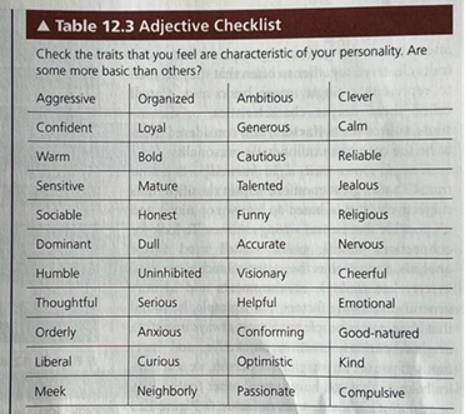
Classifying personality - Factor Analysis
Factor analysis is a statistical technique that places specific personality traits into a small number of general categories, depending on how the traits correlate with one another.
Introverted vs. extroverted
Stable vs. unstable
Used to develop the Big-5 and HEXACO models
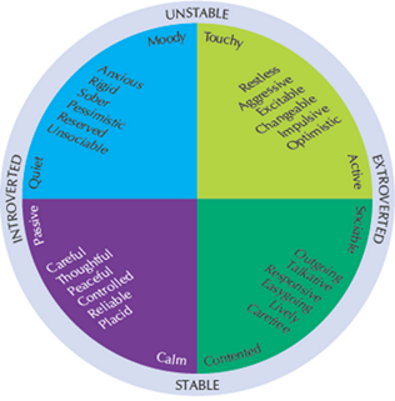
Personality Inventories
Characteristic of Personality Inventories | Explanation |
Standardized questionnaires | Ask the questions in the same way for all respondents |
Likert scales | Rate the accuracy by which your personality is captured on a scale from 1-5. Summed to calculate factor score. |
Self-report or other-report inventories | Rate your own personality or rate someone else's personality. |
MMPI-2 for example provides a statistical basis for deciding whether a person’s score on a given clinical scale is unusually high and therefore needing clinical attention
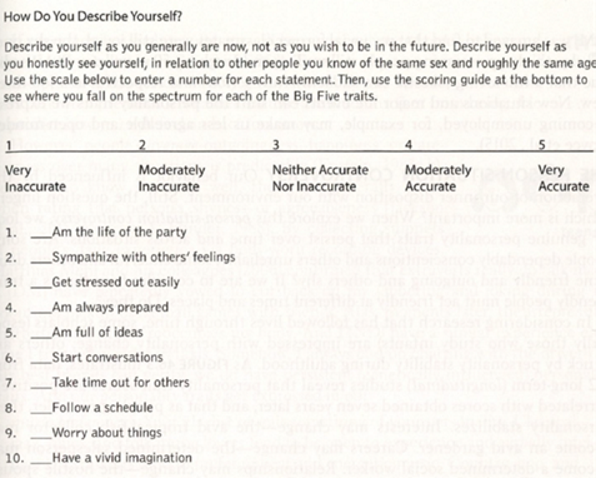
The Id
Generates unconscious, innate drives
Eros is a drive that operates according to the pleasure principle (pursues goals that give pleasure and avoid pain)
Demands immediate gratification; no regard for morals or consequences
Superego
Operates according to moral principles (internalized social and cultural values)
Acts as our conscience
Feel guilt if you desire something that violates morals
Feel pride if you do something you know is morally right
Ego
Mediates intrapsychic conflicts between the Id and Superego
Follows the reality principle: delays gratification of Id to avoid punishment and negative consequences
Must satisfy life instincts of the Id: finds an appropriate way to satisfy the Id without consequences
Must minimize guilt from Superego: strike a balance to gratify the desires of the Id.
Projective Measures
Requires respondents to describe ambiguous stimuli like the inkblot above from the Rorschach test, instead of answering direct questions
People project their unconscious thoughts and desires onto the image
Also a storytelling procedure, where patient interprets an image
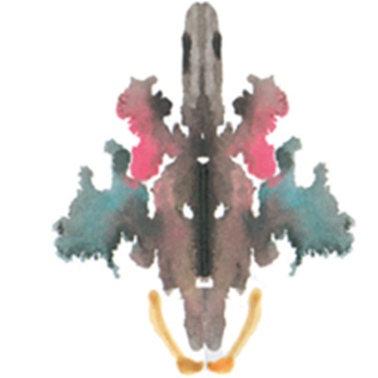
Social Learning Theory: Cognitive Behaviorism
Personality is not just due to our history of reinforcement and punishment in a situation, but how we interpret the situation. Because people can interpret the same situation differently, we need to know how they perceive the situation to predict behavior.
Psychological situation | How the person defines or interprets a situation. |
Reinforcement value | The subjective value that reinforcement has for a particular person. |
Reciprocal Determinism
Personality traits affect the situations we get ourselves into and how we react to them, which in turn influences learning that shapes our personality.
Reciprocal Determinism Mechanism | Example |
People with different personalities may choose to get involved in different situations.
| Extroverts are more likely to go to parties than introverts. |
Personalities affect how we are treated by others.
| Extroverted people are more sociable, and more likely to have people talking with them and having a good time. |
Personalities affect how we interpret and react to events.
| Introverts might be more hurt by someone rolling their eyes when they are trying to be funny, discouraging them from being social in the future. |
Carl Roger’s Self Theory
Personality problems result from incongruence, big differences between different versions of the self:
Self-image: Subjective perceptions of who you think you are
Ideal self: Person you would like to be
True self: Person you actually are
Congruence develops when:
your parents love you and accept you for who you are
you can be yourself as you go through life (organismic valuing)
self-image fits with true self and ideal self because you can naturally be yourself (self-actualization)
Incongruence develops when:
parents love is conditional
you don’t think of yourself as good, lovable, and worthwhile
you have to pretend to be someone you’re not to meet parents expectations
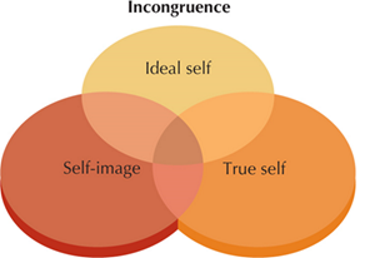
Criteria for defining psychological disorders
Psychological dysfunction: disturbance in thoughts, emotions, or behaviour due to psychological or biological systems not functioning properly
Social nonconformity: failure to conform to societal norms or standards for acceptable conduct
Subjective discomfort: private feelings of pain, unhappiness, or emotional distress
Maladaptive behaviour: impairments in social and occupational functioning
Statistical abnormality: thoughts, emotions or behaviour have a statistically extreme level of frequency or duration (MMPI-2)
Conditioning of Anxiety Disorders (Little Albert)
Classical: Stimulus generalization occurs when conditioned fears generalize to objects or situations similar to those present when classical conditioning took place.
Operant: Negative reinforcement occurs when a response is followed by an end to discomfort or by the removal of an unpleasant event, which makes the response likely to be repeated because it provides relief.
Helplessness theory of Depression
People are more likely to develop a mood disorder if they have an automatic, pessimistic explanatory style
Internal attributions: assume that a problem was caused by personal failings
Stable attributions: assume that a problem is permanent and unlikely to change, rather than temporary
Global attributions: assume that a problem will affect a wide range of situations
Stress-vulnerability model
Greater risk of a disorder when there is a pre-existing vulnerability and high levels of stress
The vulnerability or stress on its own may not result in a disorder
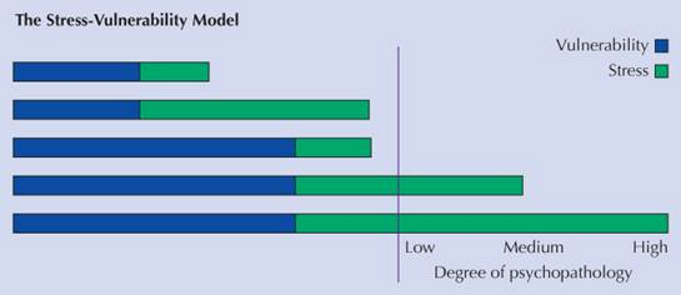
Dopamine Hypothesis: Schizophrenia
Neurons using dopamine neurotransmitters are too active
Antipsychotic drugs are dopamine antagonists
Dopamine agonists increase symptoms in people with schizophrenia (e.g. cocaine)
Psychoanalytic techniques
Technique | Explanation |
Free Association
| Client speaks in a stream of consciousness, saying whatever comes to mind without censorship. |
Interpretation (3 specific kinds of interpretation discussed below in table) | Directive technique, looking for clues about these conflicts, something that reveals itself when the client is doing free association
|
Dream Analysis |
|
Analysis of Resistance | Occurs when the client seems reluctant to continue with a topic of free association. This is thought to be a sign of an unconscious conflict that the client does not want to confront consciously. |
Transference |
|
Client-centered therapy
Technique | Meaning/Purpose |
Unconditional positive regard | Respect and acceptant; non-judgmental and warm therapeutic environment; fosters self-acceptance. |
Being authentic and genuine | Model self-acceptance to foster congruence |
Empathy | Try to understand the meaning of events from the client’s perspective |
Exposure therapy
Breaking association between conditioned stimulus and unconditioned stimulus
Technique or Goal | Explanation |
Safe exposure | Instead of avoidance. Confront the situation and feel safe doing so. |
Fear hierarchy | Rank feared situations from least to most frightening and encourage gradual exposure. |
Imaginal/virtual reality exposure | Practice before real-life exposure (using simulations, imagination, virtual reality) |
Relaxation or coping skills | Help client to stay calm in exposure situation |
Therapist support | Positive reinforcement; modeling; reality testing |
Cognitive restructuring (cognitive therapy)
Directive and active for of therapy to replace negative thoughts with more realistic and constructive ones
Cognitive Restructuring Technique | Explanation |
Identify automatic negative thoughts | About events in their life that make them more likely to become depressed
|
Reality test automatic thoughts | What evidence supports their conclusions, and is there another way to look at the situation. Usually makes people realize that there is not much evidence supporting their conclusions. |
Replace with realistic, constructive thoughts | Can make the person feel better. Find evidence against their negative thoughts. |
Evidence the psychotherapy is effective
| No Treatment or Waitlist Control Group | Drug/Attention Placebo or Alternative Treatment Control Groups |
Control natural improvement? | Yes | Yes |
Control placebo effects? | No | Yes |
Reason? | Passage of time applies to treatment and control group | Non-specific aspects causing expected benefits of therapy in treatment and control group |
Meta-analysis shows that the average psychotherapy client in the treatment control achieves better outcomes that 80% of individuals in control groups
Differences in mental health professions
Profession | Tasks |
Registered Clinical Psychologists |
|
Psychiatrists |
|
Social Workers |
|
Counsellors |
|
Registered Psychotherapists |
|